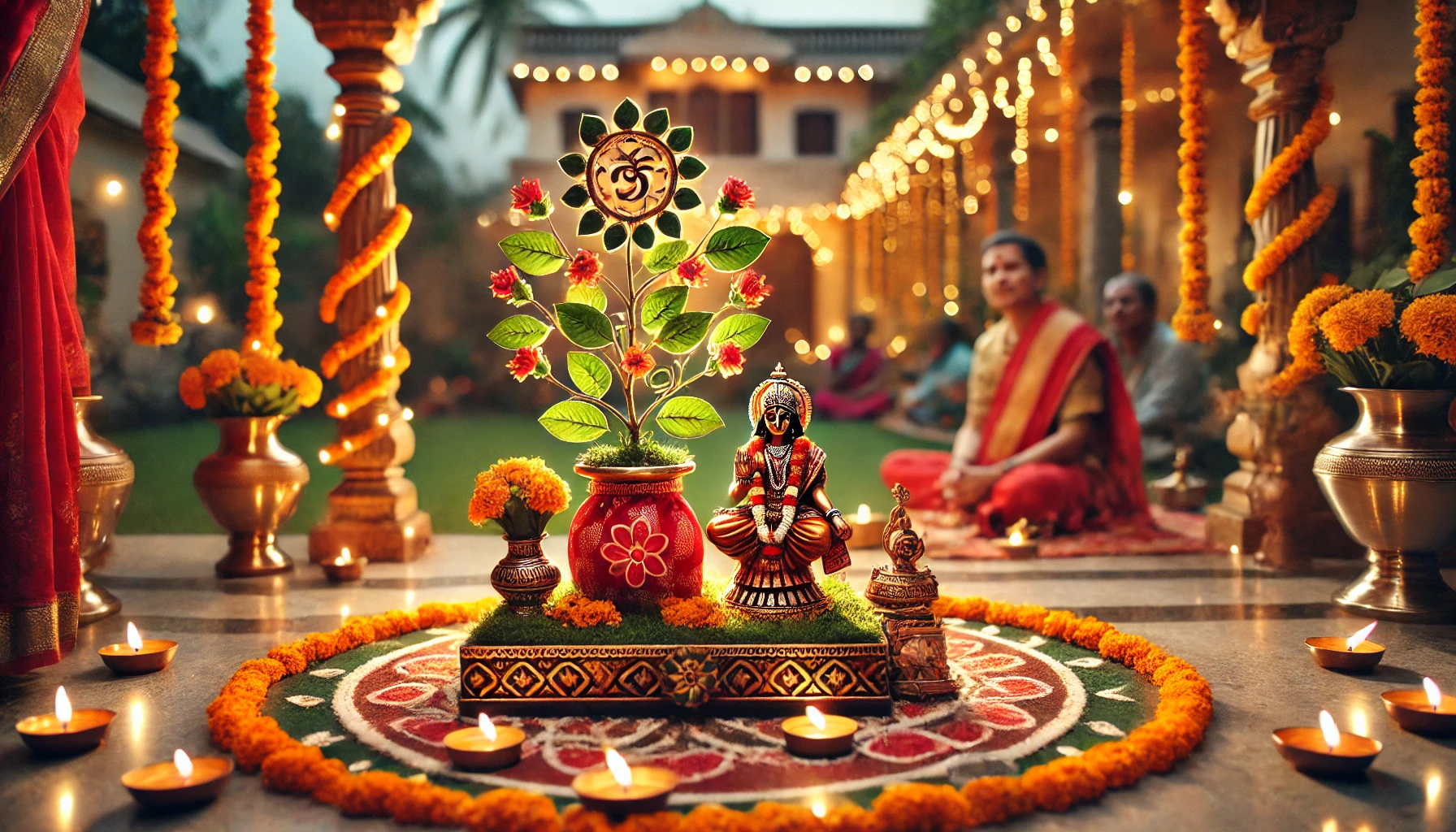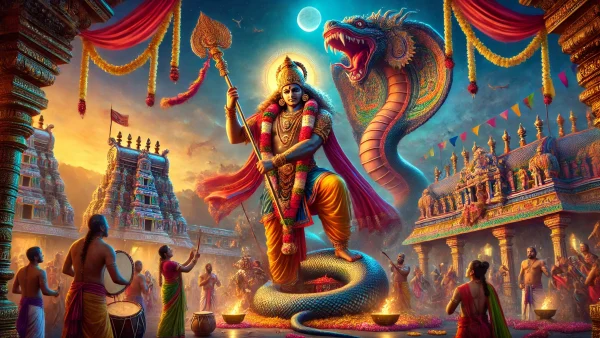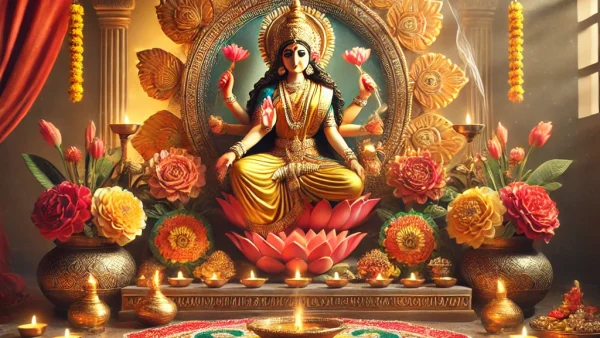Tulasi Vivah festival, a unique and revered tradition in Hindu culture, represents the sacred marriage of the holy Tulasi plant (often called the “Queen of Herbs”) with Lord Vishnu. This ceremony, typically observed in the Hindu lunar month of Kartik, has enchanted devotees for centuries with its blend of religious devotion, cultural significance, and symbolism of prosperity and renewal.
Understanding Tulasi Vivah
Tulasi Vivah is celebrated across India, where households and temples alike host the ceremony as a symbolic union that heralds a fruitful season ahead. This event, which usually takes place after Diwali, is seen as an auspicious beginning for new ventures and relationships. It combines both historical roots and spiritual beliefs, showing the interwoven nature of the physical and divine in Hinduism. This blog will explore the essence of Tulasi Vivah, its origins, the rituals involved, and why it holds a special place in the hearts of devotees.
Story Behind Tulasi Vivah – A Divine Love Story
The story of Tulasi Vivah is rooted in ancient Hindu scriptures and mythologies, adding layers of meaning and context to the festival. The tale tells of Tulasi (also known as Vrinda), who was a devoted wife of the demon king Jalandhar. Her unwavering faith and chastity rendered Jalandhar invincible, making him a formidable opponent even to the gods. In order to save the world from Jalandhar’s tyranny, Lord Vishnu assumed the form of Jalandhar and broke Vrinda’s chastity, ultimately leading to Jalandhar’s demise.
Feeling betrayed, Vrinda cursed Lord Vishnu to turn into a stone, thus transforming him into the Shaligram stone, a revered symbol of Vishnu. In return for her sacrifice and devotion, Vishnu blessed Vrinda, promising to marry her in the form of the Tulasi plant. Thus, Tulasi Vivah commemorates this union, symbolizing the victory of good over evil and the power of unshakeable devotion.
When is Tulasi Vivah Celebrated?
Tulasi Vivah typically occurs during the Kartik month (October-November), spanning from Prabodhini Ekadashi to Kartik Purnima. Many households celebrate it on Ekadashi, while others might observe it on subsequent days, each adhering to local traditions and beliefs. This period is considered highly auspicious, and it also marks the end of the Chaturmas, a four-month period when marriages and significant rituals are generally avoided. Thus, Tulasi Vivah heralds the beginning of the Hindu wedding season and is often seen as the ‘first wedding’ of the season.
Significance of the Tulasi Plant in Hinduism
The Tulasi plant, beyond its role in Tulasi Vivah, occupies a unique position in Hindu households and temples. Revered as a sacred herb, it is often placed in the center of a courtyard or garden, symbolizing purity, devotion, and protection.
- Spiritual Significance: Tulasi is believed to be an earthly manifestation of Goddess Lakshmi, the consort of Lord Vishnu. Thus, offering water and prayers to Tulasi daily is akin to worshipping Lakshmi, inviting her blessings for prosperity and peace.
- Medicinal Properties: The plant is known for its healing properties and is used in Ayurveda for its antibacterial, antifungal, and antiviral benefits. For centuries, Tulasi leaves have been part of traditional Indian medicine, treating ailments from common colds to complex health issues.
- Symbol of Devotion: Tulasi symbolizes unwavering faith and dedication, virtues that Vrinda epitomized. Her transformation into the Tulasi plant and her subsequent marriage to Vishnu represent the strength of pure devotion and the eventual union with the divine.
Rituals and Traditions of Tulasi Vivah
The rituals performed during Tulasi Vivah can vary, but the structure generally mirrors a traditional Hindu wedding ceremony. Here is a breakdown of the key rituals involved:
- Preparations: In preparation, a small altar is created in the household or temple where the Tulasi plant is cleaned, adorned with decorations, and dressed in a sari to symbolize the bride. A Shaligram stone or an idol of Lord Vishnu is prepared as the groom, complete with wedding attire.
- The Ceremony: The ceremony typically involves the same steps as a Hindu wedding, including the invocation of deities, a welcoming ritual (known as aarti), and the exchange of garlands between Tulasi and Vishnu. Devotees chant prayers and sing bhajans dedicated to the divine couple as a priest officiates.
- Offering Prasad: Offerings like sweets, fruits, and dishes made from jaggery and coconut are common. After the rituals, these offerings are distributed as prasad, symbolizing the blessings of the divine couple.
Tulasi Vivah and Its Relevance in Modern Times
While Tulasi Vivah has deep historical roots, it continues to be relevant and cherished even in today’s fast-paced world. Here are a few reasons why:
- Promotes Environmental Awareness: Tulasi Vivah also serves as a gentle reminder of the importance of nature and the environment. Many families plant new Tulasi saplings during this period, contributing to ecological preservation.
- Brings Families Together: The ceremony encourages family bonding, as members come together to prepare, celebrate, and feast. This makes Tulasi Vivah an opportunity for togetherness and the passing down of traditions to younger generations.
- Symbolizes Hope and Renewal: The Tulasi Vivah celebration is an expression of hope and renewal. As it marks the beginning of the wedding season, it also symbolizes new beginnings and opportunities.
A Family Tradition
In many families, Tulasi Vivah is more than a ritual; it’s a tradition handed down through generations. Take, for example, the Sharma family, who have celebrated Tulasi Vivah for over fifty years. Every year, they gather in their ancestral home to honor Tulasi, each family member assigned a role, from decorating the plant to reciting prayers. For them, the ritual is not just a celebration; it’s a reaffirmation of their values and beliefs, creating memories and reinforcing bonds.
The Spiritual Message of Tulasi Vivah – Devotion Over Materialism
At its core, Tulasi Vivah celebrates a devotion that transcends material wealth, power, or personal gain. Vrinda’s story is a reminder that dedication to righteousness, compassion, and unwavering faith is the highest form of devotion. By honoring Tulasi Vivah, devotees reaffirm their commitment to these virtues.
The union of Tulasi and Vishnu serves as a metaphor for the divine connection that humans can aspire to achieve through love and devotion. It signifies that true happiness and fulfillment lie in selfless service, faith, and the pursuit of spiritual connection, rather than in the accumulation of material wealth.
Embracing the Spirit of Tulasi Vivah in Daily Life
Even beyond the rituals, the spirit of Tulasi Vivah can be carried into daily life. Practicing compassion, maintaining devotion in our actions, and respecting nature are all ways to embody the essence of this festival. Tulasi Vivah reminds us to cherish both our spiritual and earthly connections, reinforcing that devotion and environmental stewardship go hand in hand.
Concluding Thoughts
Tulasi Vivah is a festival rich in history, symbolism, and relevance, resonating deeply with Hindu values and spiritual beliefs. It stands as a testament to the power of devotion, the importance of family, and the timeless connection between humanity and nature. This sacred union of Tulasi and Vishnu reminds us that love, compassion, and faith are the foundations of a fulfilling life.
As you celebrate Tulasi Vivah, may the blessings of Tulasi and Vishnu fill your life with prosperity, peace, and divine grace.
To celebrate Tulasi Vivah in the traditional way, a Shaligram is essential, representing Lord Vishnu in the ceremony. You can purchase authentic Shaligrams at spiritualguru.lk, a reliable source for spiritual accessories that help you honor this sacred union with devotion and completeness.







Leave a comment